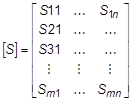General Element
Description: Defines a general element.
Format:

UIm - The last item in the UI list will appear in one of fields 2, 4, 6, or 8.

UDn - The last item in the UD list will appear in one of fields 2, 4, 6, or 8.

KZmm - The last item in the K or Z matrix will appear in one of the fields 2 through 9.

Smn - The last item in the S matrix will appear in one of fields 2 through 9.
Example:

| Field | Definition | Type | Default |
|---|---|---|---|
| EID | Element identification number. | Integer > 0 | Required |
| Uli, Cli UDj, CDj | Identification numbers of coordinates in the UI or UD list, in sequence corresponding to the
 , ,
 , and , and
 matrixes. UIi and UDi are grid point numbers, CIi and CDj are the component numbers. matrixes. UIi and UDi are grid point numbers, CIi and CDj are the component numbers.
|
Integer ≥ 0 | |
| KZij | Values of the
 or or
 matrix ordered by columns from the diagonal, according to the UI list. matrix ordered by columns from the diagonal, according to the UI list.
|
Real | Required |
| Sij | Values of the
 matrix ordered by rows according to the UD list. matrix ordered by rows according to the UD list.
|
Real | See Remark 1 |
| UD, K, Z, and S | Character variables that indicate the start of data belonging to the UD list or the
 , ,
 , or , or
 matrixes. matrixes.
|
Character |
Remarks:
- The stiffness approach:

The flexibility approach:

where,
 and
and



The required input is the
 list and the lower triangular portion of
list and the lower triangular portion of
 or
or
 . Additional input may include the
. Additional input may include the
 list and
list and
 . If
. If
 is input,
is input,
 must also be input. If
must also be input. If
 is input but
is input but
 is omitted,
is omitted,
 is internally calculated. In this case,
is internally calculated. In this case,
 must contain six and only six degrees of freedom.
must contain six and only six degrees of freedom.
The forms shown above for both the stiffness and flexibility approaches assume that the element is a free body with rigid body motions that are defined by
 .
.
- When the stiffness matrix K is input, the number of significant digits should be the same for all terms.
- The DMIG entry offers an alternative method for inputting large matrixes.
- The general element entry in the example above defines the following:


where i-j means the j-th component of grid point i. Points 42 and 33 are scalar points.

